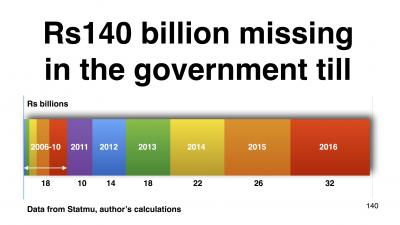At a cost of Rs18 billion. If we had grown at the 8% promised by one bean-counter for eliminating top tax brackets. As we’ve shown before the 11-year cumulative GDP shortfall at the end of 2016 was over Rs900 billion. If we assume government had reduced its revenues as a share of GDP to 15% — there was no good reason to do that though as 20% is not high given the stage of development we were at back in 2006 — then there’s about Rs139 billion of government revenue missing. As the chart shows the revenue shortfall for our government between 2006 and 2010 — which is roughly the second mandate of Ramgoolam — was already enough to pay for the Metro Express. That assumes government kept these monies in a drawer instead of investing it. By the way we’re talking 100% government financing here. 100% cash financing.
The other things that the chart tell us is that we could have financed at least one Metro Express in each of the four years starting in 2013. And more than three since Lepep took over. Or if you will with the 139 billion missing in its till over the last eleven years because of the Sithanen flat tax government would have been able to finance close to 8 Metro Express. Or 4 Metro Leger of Ramgoolam vintage with enough money left to change 78% of the leaking pipes of the CWA.
Wake up Mauritius! We’re not in the middle-income trap. We’re in the flat tax trap! It’s a lot worse but we can get out of it a lot faster.
Metro Express Shouldn’t Have Been A Burden
- Publicité -
EN CONTINU ↻


